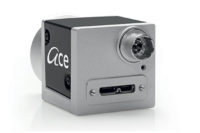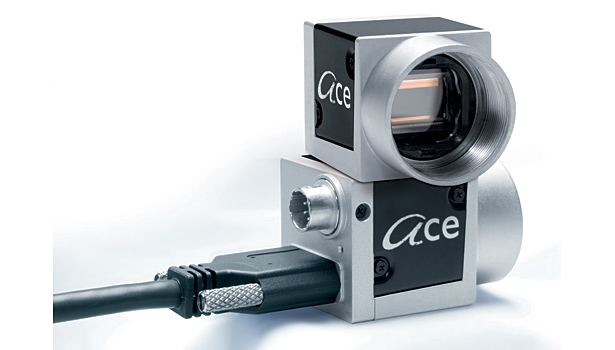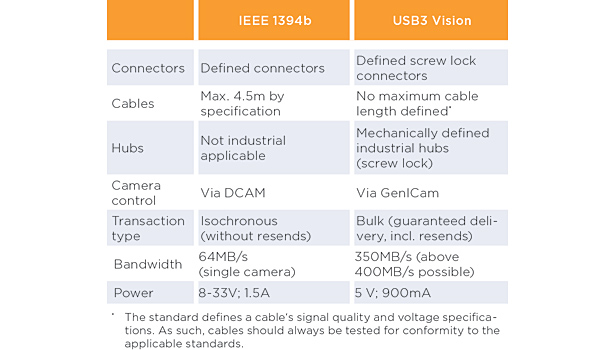FireWire Goes USB 3.0
HOW SWITCHING CAN HELP YOU.




Many people are moving from FireWire to USB 3.0. But why switch? Is the effort involved really worth it?
Users of FireWire cameras have been asking themselves these questions for some time now. They are looking for a new interface that is more powerful and technologically up-to-date. But why should anyone switch to USB 3.0 when their existing FireWire system is still running well? At first glance, the costs and effort of switching might seem to outweigh the benefits.
TECH TIPSIf the new camera is a USB 3.0 model with an identical sensor, then the majority of the costs will come in adjusting the software to the new camera interface. Some small hardware changes may be necessary to ensure the mechanical seat of the camera and to ensure the proper ports and cables are in place.
If the USB 3.0 camera uses the same sensor, then the optics, machine mechanics and lighting |
But there is an important reason to make the leap: FireWire is no longer being supported.
USB 3.0 is 100% compatible with industrial use, and offers a broader bandwidth than FireWire. The switch to USB 3.0 will come sooner or later for everyone, as FireWire is no longer being supported. Many modern operation systems, notably including Windows 8, do not include support for FireWire. USB 3.0 by contrast is ready to go out of the box.
By switching as early as possible, users can ensure a smooth and predictable workflow for their cameras. Furthermore, FireWire is already being used less frequently in new installations. Based on history, it can thus be expected that hardware costs will begin rising, both for components and accessories. The USB 3.0 market by contrast is in full growth mode. So switching from FireWire to USB 3.0 can cut costs during the first year, even when factoring in the costs of converting to the new standard. Even greater savings could be within reach in the years that follow. From a technology standpoint, a switchover to USB 3.0 is relatively easy and fast. A specialist needs no more than one day to convert software to handle USB 3.0. The existing system setup can often remain in place if the sensor sizes on the new and old cameras match.
The switch is then easy and economical. USB 3.0 is a perfect successor technology, combining plug and play functionality with a greater bandwidth, significantly lower CPU load and extremely precise real-time compatibility.
Key benefits at a glance:
FireWire hardware is growing more expensive and is expected to disappear from the market in the medium term.
Changes to software or migration to other operating systems often make a switch necessary. Microsoft’s current OS, Windows 8, offers no built-in support for FireWire, whereas USB 3.0 Host Controller is integrated out of the box and requires no additional driver installation.
USB 3.0 offers greater bandwidth, a significant factor when considering the expected future requirements for vision systems, such as higher frame rates, higher resolution and a different pixel format.
The savings within the overall system justify the one-time integration costs.
The Technology: FireWire in comparison with USB 3.0
The technical characteristics for the FireWire interface are similar to those USB 3.0 interface and its relevant standard, USB3 Vision, making them very well suited as a successor standard. In many points, USB 3.0 represents real improvement over FireWire.
Low CPU load and good real-time compatibility are two points in favor of USB3.0. Even when being used at the maximum data rate of 350MB/s, transmission via USB 3.0 barely troubles the CPU. This comes courtesy of the Direct Memory Access (DMA) mechanism using by USB 3.0 on the host computer. Before data transmission even begins, DMA reserves memory for direct write access by DMA—no copy process required.
Only a very minor difference between the gross and net data rates remains, attributable to the low overhead performance.
Quantities such as latency and jitter are decisive for quantifying the real-time compatibility of vision systems. Latency times encompass the absolute measured time required by a system before the actual image capture or processing can transpire. In layman’s terms, it is the dead period during which the system is busy with internal instructions. Jitter by contrast describes the time variation from one process step to the next identical process step (in this case the image capture and processing). Temporal jitter is thus the most important quantity for accurate predictions on how precisely the working cycle for a vision system can be adjusted to the cycle times on a process to be monitored, presuming that process relies completely on an upstream process. Measurements on real-time compatibility show that USB 3.0 offers shorter latency and briefer jitter times than FireWire, and is the better suited interface in terms of real-time compatibility.
The Cost of Switching: Changes to Hardware and Software
What changes are needed to switch from FireWire to USB 3.0 hardware and software? Let’s take as our example a classic camera-based inspection system. The geometry of the system is adapted based on the lens being used for the sensor and object, meaning the distance between camera and object are set to correspond to the resolution requirements and in some cases for the illumination of the object as well. The simplest way to convert this system to USB 3.0 is to use a USB 3.0 camera with the same sensor. Doing so allows for the same optical setup to be retained. This is not always the case, however. Even if a USB camera with the identical sensor cannot be found, there are frequently alternatives available with a different sensor of the same or similar size and sensitivity levels comparable with the previous camera. The casing size for the USB 3.0 camera can also be important if space is at a premium. Minor deviations are acceptable, but it should certainly not be larger than the FireWire camera that was previously being used. It’s always helpful if the new camera also uses the same fastening schematics as the previous one.
The portion of the system from camera to computer is often easier to switch: In FireWire systems, the camera communicates with the PC using a FireWire cable plugged into a PCIexpress card or directly into the motherboard, presuming the latter has a direct FireWire port. In many cases there is also an additional cord used for precise triggering of the camera. When switching to USB 3.0, the cable must always be switched. In many applications the PCIexpress card can be swapped out, or—if the PC hardware is being modernized at the same time—the entire PC is replaced.
This ensures that the one-time financial outlay for all hardware changes is quantifiable and manageable. If one examines the long-term costs of ownership for each system, newer PC hardware typically is more cost effective.
And in terms of software?
Integration costs vary based on the specific software being used. Let’s explore two cases that mark the potential extremes:
Variant 1: If customized, proprietary software is being used—DCAM-based software is one example—and that software only supports DCAM cameras, then it is no easy task to adjust it to cameras with different, more modern interface standards.
The software interface must first be reprogrammed to the GenICam standard. This does have one clear benefit: Once the port to GenICam has been created, it will work with other current machine vision software ports and is now more flexible for the future, since GenICAm is the standard that all interface technologies must meet.
Variant 2: The existing software environment is already compatible with GenICam. A few adjustments are required, no more. Ideally that means an update of all drivers for USB3 Vision and the camera controller and you’re good to go.
Summary from Cost Viewpoint
From a procurement standpoint, the switch to USB 3.0 pays for itself. If the new camera is a USB 3.0 model with an identical sensor, then the majority of the costs will come in adjusting the software to the new camera interface. Some small hardware changes may be necessary to ensure the mechanical seat of the camera and to ensure the proper ports and cables are in place. If the USB 3.0 camera uses the same sensor, then the optics, machine mechanics and lighting can be reused.
In general, the break-even point is reached during the first year. Five-digit savings are then possible in the year that follows, with no further cost-cutting measures required.
Looking for a reprint of this article?
From high-res PDFs to custom plaques, order your copy today!






